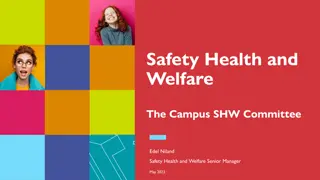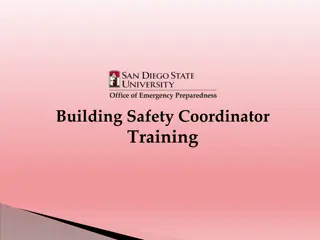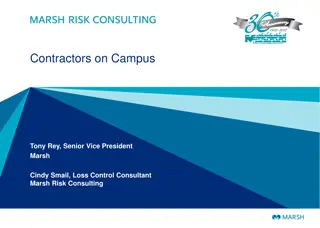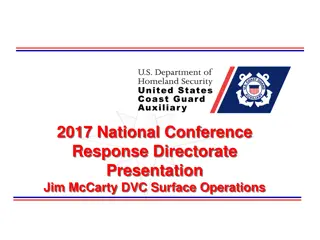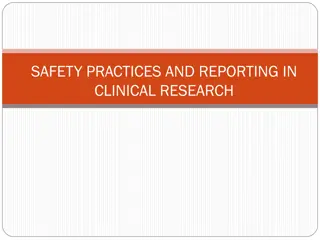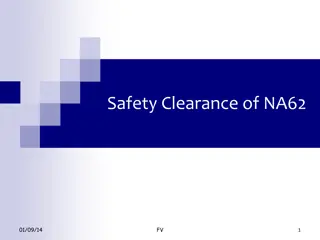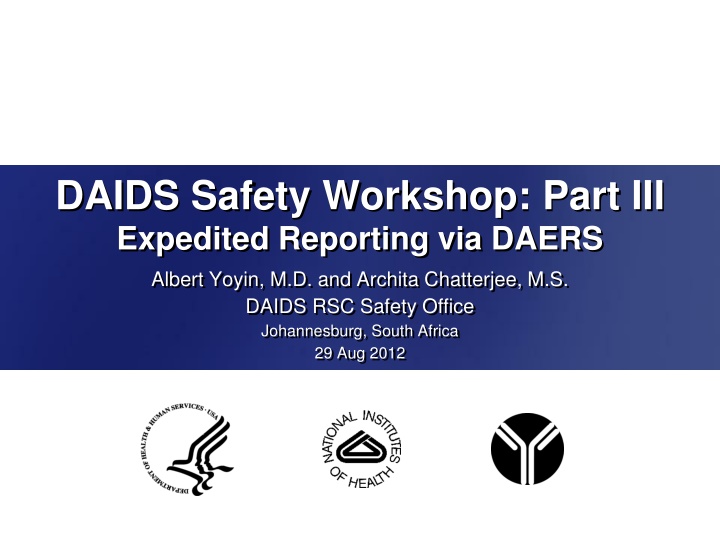
Enhancing Expedited Reporting in DAERS for Safety Workshop Participants
Explore the key features and updates of DAIDS Adverse Experience Reporting System (DAERS) presented during the safety workshop in South Africa. Learn about the system overview, new features, integration process, and site-specific functionalities to streamline expedited reporting to DAIDS. Discover the significance of EAE reports submitted by different networks and protocols, highlighting the importance of timely reporting in ensuring participant safety.
Download Presentation

Please find below an Image/Link to download the presentation.
The content on the website is provided AS IS for your information and personal use only. It may not be sold, licensed, or shared on other websites without obtaining consent from the author. If you encounter any issues during the download, it is possible that the publisher has removed the file from their server.
You are allowed to download the files provided on this website for personal or commercial use, subject to the condition that they are used lawfully. All files are the property of their respective owners.
The content on the website is provided AS IS for your information and personal use only. It may not be sold, licensed, or shared on other websites without obtaining consent from the author.
E N D
Presentation Transcript
DAIDS Safety Workshop: Part III Expedited Reporting via DAERS Albert Yoyin, M.D. and Archita Chatterjee, M.S. DAIDS RSC Safety Office Johannesburg, South Africa 29 Aug 2012
Objectives DAERS Overview New DAERS Features for v2.0 DAERS Usage Common queries to sites Case Study 2
DAERS DAERS: DAIDS Adverse Experience Reporting System An integrated module that is part of the DAIDS Enterprise System (DAIDS-ES) A secure, confidential, web-based system through which sites are required to submit expedited reports to DAIDS For sites where DAERS has been implemented, all SAEs and supporting information will be submitted to DAIDS using the DAERS, unless the system is unavailable for technical reasons Use DAIDS EAE Reporting Form if DAERS is not implemented 3
DAERS Overview DAERS system planning initiated in 2005 DAERS v1.0 online Jun 2008 Updates to the system ~q6 mos; v2.0 as of Jun 2012 DAERS Integration Group (DIG) meets regularly to address current technical issues and system changes SMEs (DAIDS MOs, SPT, and RSC personnel) provide input to DAIDS-ES programmers Monthly calls with all collaborators group (site personnel, DMCs, network representatives) 4
New Features in DAERS (v2.0 update) DAERS Version 2.0 was implemented on 22 Jun 2012 Site-specific features: Make specific fields (such as severity grade, status code, and status date) optional if event is not an SAE but is required to be reported to DAIDS, or is of sufficient concern to warrant informing DAIDS Date of death field added; only required when the event being submitted indicates Death ; otherwise field is disabled/grayed out Force change of status date when changing status code/outcome for update reports 5
EAE Reports Submitted by Networks (Jan 2011 Mar 2012) 5% 10% ACTG IMPAACT HPTN HVTN MTN Non-network 28% 44% < 1% 13% Total = 507 6
EAE Reports Submitted by Protocol (Jan 2011 Mar 2012) 24% 29% PROMISE HPTN 052 MTN 003 P1060 Others 7% 12% 28% Total = 507 7
Average DAERS Usage (Jan 2011 Mar 2012) 25% RSC Sites 75% Total = 512 8
DAERS Usage by Protocol (Jan 2011 Mar 2012) 96% 100% 92% 92% 90% 80% 75% 70% PROMISE A5257 HPTN 052 MTN 003 Others (45) 60% 50% 41% 40% 30% 20% 10% 0% PROMISE A5257 HPTN 052 MTN 003 Others (45) 9
Non-DAERS Usage Sites unable to access DAERS Inability to connect to Internet DAERS system unavailable (e.g., down for maintenance) Site personnel not authorized to access DAERS (e.g., have not taken DAERS training; no Physician Electronic Signature Attestation Form received for submitter) Site personnel unable to access DAERS (e.g., forgot password) Sites reporting on older SAE reporting category protocols (e.g., P1020A and P1026s) 10
Late Submissions to RSC Waiting for additional information (e.g., discharge summary, lab reports, etc.) Reportability (e.g., questions regarding the reportability of an event; sites unaware that multiple reports are required when multiple Primary AEs were identified) System access (e.g., inability to connect to the Internet or to DAERS) SAE was overlooked as needing to be reported No back-up submitter available 11
RSC Queries to Sites 17% 29% Narrative Missing info Primary AE term Reportability Other 19% 27% 8% Total = 109 12
Breakdown of RSC Queries to Sites Narrative (e.g., medical history/event details; AE status/resolution; treatment/management for AE) Reportability (e.g., justification for ICH SAE criteria, severity grade, and/or relationship assessment) Primary AE term (e.g., reporting ambiguous terms or multiple AEs in one term; ICH SAE criteria as AEs) Missing info (e.g., source documents, con meds, CD4 count/viral load, enrollment date) Other (e.g., PI signature, amending onset date, amending status/status date) 13
Examples of RSC Queries to Sites Ambiguous AE terms which cannot be coded in MedDRA The reporting of hospitalization as an adverse event instead of reason for hospitalization The reporting of death as an adverse event instead of cause of death Wrong dates (e.g., DOB, awareness, start) inconsistent with narrative Errors in the selection of the SAE criteria (e.g. life-threatening anemia but assigned as Grade 2) Accurate information about study drugs (e.g. dose, schedule, start and stop dates) Missing information (e.g. lab results, diagnostic test results, con meds, supporting information such as progress notes, death certificates) 14
Case Study: Intrauterine Fetal Demise CASE STUDY TO BE REVIEWED FOR 5 MINUTES 15
Case Study: Intrauterine Fetal Demise 6 Jun 2011: 31 year old, HIV infected Black female enrolled in 1077BF (PROMISE) 17 Jun 2011: subject was ~ 20 wks. pregnant and presented to the hospital with lower abdominal pain (Grade 2), vaginal bleeding (Grade 2), and abdominal contractions BP: 142/72 mmHg, Pulse: 140 bpm, T: 35.9 C, and Hgb: 9.5 g/dL US confirmed no fetal heartbeat and no liquor Later on the same day, the subject s fetus was expelled; the placenta and membranes were noted as healthy and complete 16
Case Study: Intrauterine Fetal Demise Reporter and Site Information Site Awareness Date: The date the site first became aware of the adverse event occurring at a reportable level Date adverse event (AE) occurred 17 Jun 2011 Date serious adverse event (SAE) occurred 17 Jun 2011 Date site aware event occurred at a reportable level 17 Jun 2011 17
Case Study: Intrauterine Fetal Demise Timeline for Submission: Must submit within 3 reporting days of site awareness June 2011 Sunday Monday Tuesday Wednesday Thursday Friday Saturday 1 2 3 4 5 6 7 8 9 10 11 12 13 14 15 16 17 18 Site Awareness (2 PM local time) 19 20 21 22 23 24 25 Report Due (11: 59 PM Local Time) 26 27 28 29 30 18
Case Study: Intrauterine Fetal Demise Primary Adverse Event Seriousness Criteria Select appropriate ICH-SAE criteria More than one criteria can be selected Requires inpatient hospitalization or prolongation of existing hospitalization Primary Adverse Event Intrauterine fetal demise Severity Grade Grade 3 (Severe) 19
Case Study: Intrauterine Fetal Demise Primary Adverse Event (cont d) Onset Date: The date the primary adverse event first occurred at the level requiring expedited reporting 17 Jun 2011 Country of AE Origin: The country where the event occurred; may not necessarily be where the site is located South Africa 20
Case Study: Intrauterine Fetal Demise Primary Adverse Event (cont d) Status Code at Most Recent Observation: The status code of the subject at the most recent observation Recovering/Resolving Status Date: Date of the most recent observation of the subject Date should be on or after the site awareness date Date of most recent observation for subject status can be at or after the site is aware of the occurrence of the event 17 Jun 2011 21
Case Study: Intrauterine Fetal Demise Case Narrative Provide information on reported Primary AE Describe: clinical course therapeutic measures outcome relevant past medical history concomitant medication(s) alternative etiologies any contributing factors all other relevant information 22
Case Study: Intrauterine Fetal Demise Study Agent 1 Lopinavir/Ritonavir Study Agent 2 Lamivudine/Zidovudine 23
Case Study: Intrauterine Fetal Demise Study Agents Not a free text field Choose study agent from drop down menu of smart text field Study Agent 1: Lopinavir/Ritonavir Study Agent 2: Lamivudine/Zidovudine 24
Case Study: Intrauterine Fetal Demise Study Agents (cont d) Relationship of Study Agent 1 to Primary AE Related Dose and Unit of Measurement 200/50 mg Date of First Dose 6 Jun 2011 Date of Last Dose: The date the subject took the last dose prior to the onset of the adverse event 16 Jun 2011 25
Case Study: Intrauterine Fetal Demise Study Agents (cont d) Exposure to and duration of use of study agent is important information to assess the case Ensure accuracy of information If unsure, please notate that the date is estimated 26
Case Study: Intrauterine Fetal Demise Study Agents (cont d) Action Taken: Enter the study physician s action taken with the study agent after awareness of the SAE Continued without change Action Date: Date has to be on or after the site awareness date, i.e., study physician can take action with the study agent only after the site is aware the AE has occurred at a reportable level 17 Jun 2011 If action taken is Course completed or Off Study Agent at AE Onset, action taken can be left blank 27
Case Study: Intrauterine Fetal Demise Concomitant Medications: Folic Acid Ferrous Sulfate Amoxicillin Other Events: List other clinically significant signs and symptoms that more fully describe the nature, severity, and/or complications of the Primary AE Abdominal Pain Vaginal Bleeding 28
Case Study: Intrauterine Fetal Demise Laboratory Tests: Hemoglobin Diagnostic Tests: Abdominal ultrasonography 29
Teaching Points Mandatory reporting fields for DAERS does not equal adequate information about the case Not just what the system (i.e., DAERS) requires as mandatory fields: Participant ID Site ID Protocol ID Protocol version Site Awareness date SAE Criteria Primary AE Severity Grade Onset Date Status Code Status Date Narrative Study Agent/Product Relationship Dosing details Other events Reporter name Reporter E-mail 30
Case Study: Intrauterine Fetal Demise Reporter: Completes and sends the report for final review Submitter: Reviews and submits the Report to DAIDS E-mail notification of expedited report submission sent to CRS staff and other key stakeholders Site responsibility to ascertain that the report was, in fact, submitted 31
Case Study: Intrauterine Fetal Demise UPDATE 32
Case Study: Intrauterine Fetal Demise Primary Adverse Event Status Code at Most Recent Observation: Recovered/Resolved Status Date: Date of the most recent observation of the subject 20 Jun 2011 Case Narrative 18 Jun 2011: discharged from hospital 20 Jun 2011: evaluated in study clinic Additional Information Upload discharge summary 33
Case Study: Intrauterine Fetal Demise Submission of UPDATE Completion Check to put the EAE Report in Ready for Final Review Status Click View PDF Report to verify your edits have been made Update status code and status date Update case narrative Additional Information Submitter will review the report and Submit through DAERS 34
How to Report to DAIDS Reports must be submitted via DAERS: DAERS via web: https://daidses.niaid.nih.gov/Phoenix For emergency use only: FAX: +1-301-897-1710 or 1-800-275-7619 (USA only) E-mail: DAIDSRSCSafetyOffice@tech-res.com If e-mailing, scan or FAX signature page 35
Confirmation of Receipt DAERS will send a confirmation e-mail for all SAE reports It is the site s responsibility to follow up if they do not receive a confirmation e-mail 36
Where to Get Help RSC Safety Office: E-mail: DAIDSRSCSafetyOffice@tech-res.com Telephone: +1-301-897-1709 or 1-800-537-9979 (USA only) FAX: +1-301-897-1710 or 1-800-275-7619 (USA only) RSC Website: DAIDS-ES Support: https://rsc.tech-res.com E-mail: DAIDS-ESSupport@niaid.nih.gov Telephone: +1-240-499-2239 or 1-866-337-1605 (USA only) FAX: +1-301-948-2242 37
Questions? 38






